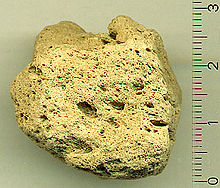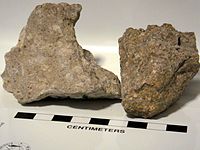This is an old revision of this page, as edited by Shellwood (talk | contribs) at 12:49, 16 January 2019 (Reverted edits by 70.50.13.183 (talk) (HG) (3.4.6)). The present address (URL) is a permanent link to this revision, which may differ significantly from the current revision.
Revision as of 12:49, 16 January 2019 by Shellwood (talk | contribs) (Reverted edits by 70.50.13.183 (talk) (HG) (3.4.6))(diff) ← Previous revision | Latest revision (diff) | Newer revision → (diff) Light coloured highly vesicular volcanic glass Not to be confused with pomace.

Pumice ( /ˈpʌmɪs/), called pumicite in its powdered or dust form, is a volcanic rock that consists of highly vesicular rough textured volcanic glass, which may or may not contain crystals. It is typically light colored. Scoria is another vesicular volcanic rock that differs from pumice in having larger vesicles, thicker vesicle walls and being dark colored and denser.
Pumice is created when super-heated, highly pressurized rock is violently ejected from a volcano. The unusual foamy configuration of pumice happens because of simultaneous rapid cooling and rapid depressurization. The depressurization creates bubbles by lowering the solubility of gases (including water and CO2) that are dissolved in the lava, causing the gases to rapidly exsolve (like the bubbles of CO2 that appear when a carbonated drink is opened). The simultaneous cooling and depressurization freezes the bubbles in a matrix. Eruptions under water are rapidly cooled and the large volume of pumice created can be a shipping hazard for cargo ships.
Properties
Pumice is composed of highly microvesicular glass pyroclastic with very thin, translucent bubble walls of extrusive igneous rock. It is commonly, but not exclusively of silicic or felsic to intermediate in composition (e.g., rhyolitic, dacitic, andesite, pantellerite, phonolite, trachyte), but basaltic and other compositions are known. Pumice is commonly pale in color, ranging from white, cream, blue or grey, to green-brown or black. It forms when volcanic gases exsolving from viscous magma form bubbles that remain within the viscous magma as it cools to glass. Pumice is a common product of explosive eruptions (plinian and ignimbrite-forming) and commonly forms zones in upper parts of silicic lavas. Pumice has an average porosity of 90%, and initially floats on water.
Scoria differs from pumice in being denser. With larger vesicles and thicker vesicle walls, it sinks rapidly. The difference is the result of the lower viscosity of the magma that forms scoria. When larger amounts of gas are present, the result is a finer-grained variety of pumice known as pumicite. Pumice is considered a glass because it has no crystal structure. Pumice varies in density according to the thickness of the solid material between the bubbles; many samples float in water. After the explosion of Krakatoa, rafts of pumice drifted through the Indian Ocean for up to 20 years, with tree trunks floating among them. In fact, pumice rafts disperse and support several marine species. In 1979, 1984 and 2006, underwater volcanic eruptions near Tonga created large pumice rafts, some as large as 30 kilometers (19 mi) that floated hundreds of kilometres to Fiji.
There are two main forms of vesicles. Most pumice contains tubular microvesicles that can impart a silky or fibrous fabric. The elongation of the microvesicles occurs due to ductile elongation in the volcanic conduit or, in the case of pumiceous lavas, during flow. The other form of vesicles are subspherical to spherical and result from high vapor pressure during eruption.
-
 Illustrates the porous nature in detail.
Illustrates the porous nature in detail.
-
 Rocks from the Bishop tuff, uncompressed with pumice on left; compressed with fiamme on right.
Rocks from the Bishop tuff, uncompressed with pumice on left; compressed with fiamme on right.
-
 A 15-centimeter (5.9 in) piece of pumice supported by a rolled-up U.S. 20-dollar bill demonstrates its very low density.
A 15-centimeter (5.9 in) piece of pumice supported by a rolled-up U.S. 20-dollar bill demonstrates its very low density.
Natural sources
In 2011, Italy and Turkey led pumice mining production at 4 and 3 million tonnes respectively; other large producers at or exceeding a million tonnes were Greece, Iran, Chile and Syria. Total world pumice production in 2011 was estimated at 17 million tonnes.
Russia
Pumice can be found in the Kamchatka Peninsula area due to the Pacific volcanic belt.
United States
In United States, pumice is mined in Nevada, Oregon, Idaho, Arizona, California, New Mexico and Kansas (ordered by production). U.S. production of pumice and pumicite in 2011 was estimated at 380,000 tonnes, valued at $7.7 million.
Uses
Pumice is widely used to make lightweight concrete or insulative low-density cinder blocks. When used as an additive for cement, a fine-grained version of pumice called pozzolan is mixed with lime to form a light-weight, smooth, plaster-like concrete. This form of concrete was used as far back as Roman times. Roman engineers used it to build the huge dome of the Pantheon and as construction material for many aqueducts.
It is also used as an abrasive, especially in polishes, pencil erasers, and the production of stone-washed jeans.
Personal care
In personal care, pumice is used as a skin exfoliants. "Pumice stones" are often used in beauty salons during the pedicure process to remove dry and excess skin from the bottom of the foot as well as calluses. It was also used in ancient Greek and Roman times to remove excess hair. Finely ground pumice is added to some toothpastes and heavy-duty hand cleaners (such as Lava soap) as a mild abrasive. Some brands of chinchilla dust bath are made of powdered pumice.
Horticulture
In horticulture, pumice is also used as a growing substrate for growing plants such as succulents and cacti. It is beneficial since it has moisture retention capability.
In 2011, 16% of pumice mined in the United States was used for horticultural purposes.
Industrial
Owing to its high demand particularly for water filtration, chemical spill containment, cement manufacturing, horticulture and increasingly for the pet industry, the mining of pumice in environmentally sensitive areas has been under more scrutiny after such an operation was stopped in the U.S. state of Oregon, at Rock Mesa in the southern part of the Three Sisters Wilderness.
See also
- Pumice raft – Floating mass of pumice in the ocean
References
- Jackson, J.A., J. Mehl, and K. Neuendorf (2005) Glossary of Geology American Geological Institute, Alexandria, Virginia. 800 pp. ISBN 0-922152-76-4
- McPhie, J., M. Doyle, and R. Allen (1993) Volcanic Textures A guide to the interpretation of textures in volcanic rocks Centre for Ore Deposit and Exploration Studies, University of Tasmania, Hobart, Tasmania..198 pp. ISBN 9780859015226
- Redfern, Simon. "Underwater volcano creates huge floating islands of rock, disrupts shipping". Phys.org. Omicron Technology Ltd. Retrieved 25 April 2014.
- Venezia, A.M.; Floriano, M.A.; Deganello, G.; Rossi, A. (July 1992). "Structure of pumice: An XPS and 27Al MAS NMR study". Surface and Interface Analysis. 18 (7): 532–538. doi:10.1002/sia.740180713.
- De Vantier, L.M. (1992). "Rafting of tropical marine organisms on buoyant coralla" (PDF). Marine Ecology Progress Series. 86: 301–302. Bibcode:1992MEPS...86..301D. doi:10.3354/meps086301. Retrieved 2007-07-14.
Trunks and pumice that washed ashore at Keeling Atoll in the early 1900s had been drifting for some 20 years, since the eruption of Krakatoa 1000 km to the northeast in 1883 (Wood-Jones 1912)
- Bryan, S.E.; A. Cook; J.P. Evans; P.W. Colls; M.G. Wells; M.G. Lawrence; J.S. Jell; A. Greig; R. Leslie (2004). "Pumice rafting and faunal dispersion during 2001–2002 in the Southwest Pacific: record of a dacitic submarine explosive eruption from Tonga" (PDF). Earth and Planetary Science Letters. 227: 135–154. Bibcode:2004E&PSL.227..135B. doi:10.1016/j.epsl.2004.08.009. Retrieved 2007-07-14.
The abundance and variety of fouling taxa, coupled with the long dispersal trajectory (> 3500 km) and period of pumice flotation (≥ 1 year), confirm the importance of sea-rafted pumice as a long-distance dispersal mechanism for marine organisms
- "New Island and pumice raft in the Tongas". NASA Earth Observatory. National Aeronautics and Space Administration. 16 November 2006. Retrieved 23 October 2016.
- ^ Crangle, Robert D. Jr. (January 2012). "Pumice and pumicite - USGS Mineral Resources Program" (PDF). United States Geological Survey. Retrieved 25 November 2018.
- Sherrow, V. 2001. For appearance' sake: the historical encyclopedia of good looks. Greenwood, ISBN 1-57356-204-1
- The Oregon Encyclopedia. Michael McCloskey (Sierra Club 2005)
External links
- University of Oxford image of pumice. Retrieved 2010-09-27.
- Analytical identification of a single source pumice from Greek shores and ancient sites in the Levant
- On the occurrence of a pumice-rich layer in Holocene deposits of western Peloponnesus, Ionian Sea, Greece. A geomorphological and geochemical approach.
- GeneralPumiceProducts.com
- Hess Pumice - White papers and technical info of pumice.